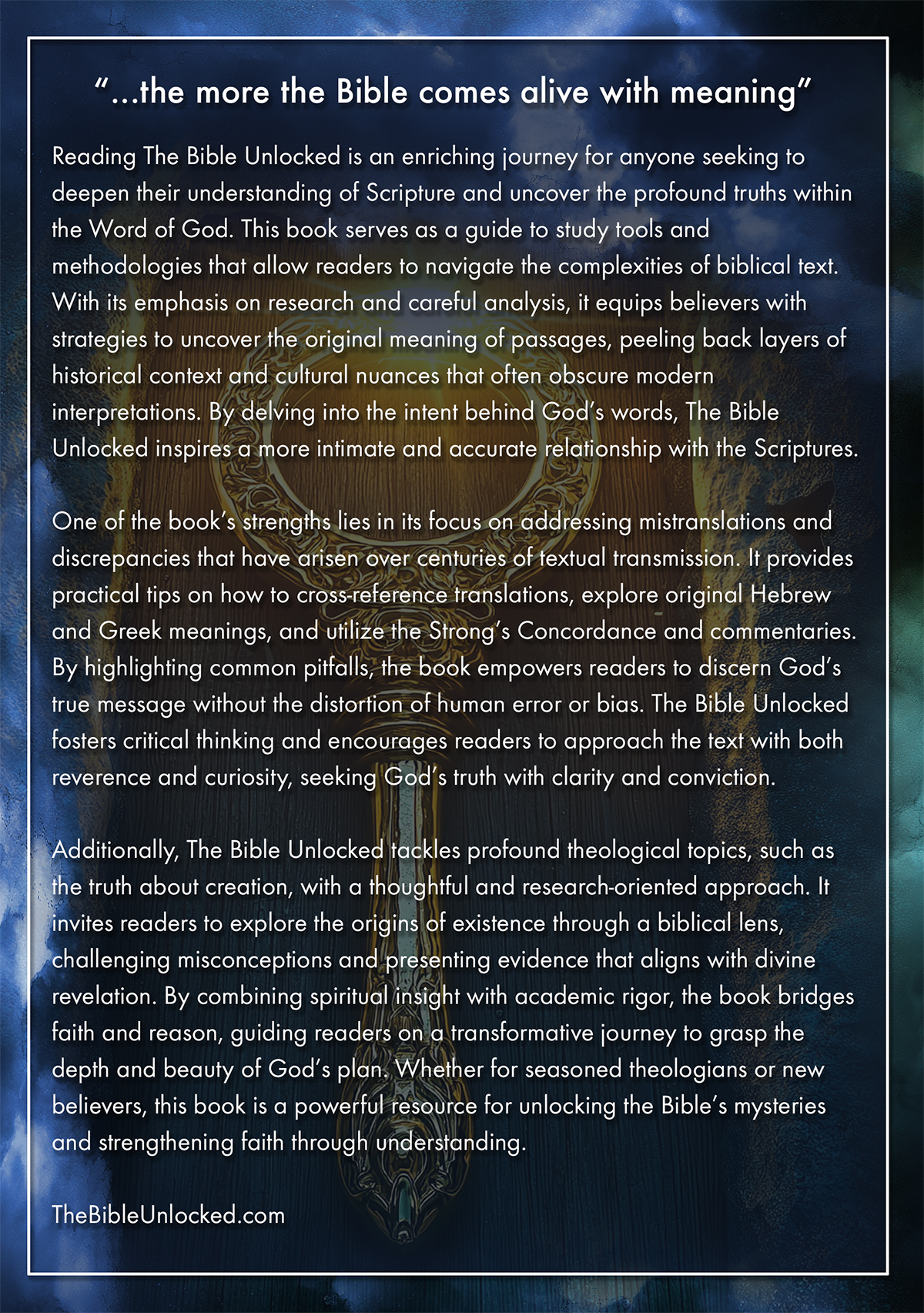

"...the more the Bible comes alive with meaning"
Reading The Bible Unlocked is an enriching journey for anyone seeking to deepen their understanding of Scripture and uncover the profound truths within the Word of God. This book serves as a guide to study tools and methodologies that allow readers to navigate the complexities of biblical text. With its emphasis on research and careful analysis, it equips believers with strategies to uncover the original meaning of passages, peeling back layers of historical context and cultural nuances that often obscure modern interpretations. By delving into the intent behind God's words, The Bible Unlocked inspires a more intimate and accurate relationship with the Scriptures.
CHAPTER 6
Throughout history, Satan and human traditions have sought to interfere with God’s plan, including attempts to disrupt the lineage of Jesus Christ. The Kenites, for instance, have played a significant role in these efforts.
In the Book of Revelation, we read about seven churches that Jesus judged, but only two were without fault: Smyrna and Philadelphia. If you’re searching for a church, consider seeking one that aligns with the teachings of these two churches.
What did Jesus say about these churches? He declared: “I know thy works, and tribulation, and poverty, (but thou art rich) and I know the blasphemy of them which say they are Jews, and are not, but are of the synagogue of Satan.”
With deeper study, one may discover that those referred to as belonging to the “synagogue of Satan” are the Kenites. Who are the Kenites? They are the descendants of Cain. And who is Cain? He is the son of Satan. Smyrna and Philadelphia were distinguished because they taught about the Kenites, a truth that many churches today neither understand nor teach.
Throughout Scripture, the Bible provides guidance on what to seek and what to avoid in walking with Christ. It offers examples of individuals who made righteous choices in following Him, as well as those who failed. By following the lessons and examples provided in Scripture, a person can live a more fulfilling and loving life that draws them closer to our Lord and Savior, Jesus Christ.
For example, the Book of Luke offers insight into the timing of Jesus’ birth. Luke recounts the story of Zachariah, a Levitical priest, and his wife Elizabeth. Zachariah served the course of Abijah, which fell between June 13th and June 19th. After completing his service, Zachariah likely arrived home between June 22nd to 24th. As was customary, he would have undergone a cleansing ritual, meaning he likely did not lay with his wife until June 23rd to June 25th. This marks the approximate conception date of John the Baptist.
By knowing John’s conception date and recognizing that he was six months older than Jesus, we can determine that Jesus was conceived on approximately December 25th. This calculation suggests that Jesus was born during the Feast of Tabernacles, around September 29th.
Scripture further supports this timeline. On the day Mary learned of her pregnancy, she immediately traveled to visit her cousin Elizabeth. Upon Mary’s arrival, John the Baptist leaped in Elizabeth’s womb, recognizing the presence of the Holy Spirit within Mary.
Reflecting on this subject, consider this: when John the Baptist, at just six months in Elizabeth’s womb, leaped at the presence of the Holy Spirit in Mary’s womb, what does this suggest about the beginning of life?
As previously noted, Satan persistently attempts to disrupt God’s plan, particularly concerning Jesus. One such interference occurred through a pagan ritual involving Claus. I encourage you to explore the origins of this by searching, “How did the pagan ritual of Santa Claus begin?”
Satan’s followers fabricated a tale of a heavyset man with a white beard and red attire, bestowing gifts upon children. Over time, this story evolved into the figure of Santa Claus, serving as a distraction from the significance of the day Jesus was conceived.
Christians are called to honor Christmas as the sacred day commemorating the conception of Jesus Christ. It is vital to teach the true essence of this celebration and remain vigilant against distractions. While Santa Claus may seem like a harmless tradition for children, perpetuating this myth promotes falsehood and inadvertently glorifies Satan. By doing so, one violates the Ninth Commandment: “Thou shalt not bear false witness against thy neighbour.” Simply put, we are commanded not to lie.
Consider the prophecy found in Psalm 22, written a thousand years before the birth of Christ. This Scripture vividly describes the final days of Jesus before His crucifixion, affirming His authenticity. No other religious figure or deity has a prophecy written one thousand years before their life that accurately foretells their end, except for Jesus Christ.
Furthermore, a thousand years before Christ’s birth, the Jewish people were instructed to place the blood of a lamb above their doorways. This act shielded their firstborn from the angel of death during the original Passover. This momentous event established the Passover tradition.
Isn’t it remarkable that Jesus was crucified during this same Jewish holiday, Passover, a thousand years later? Early scholars hesitated to refer to Jesus as our Passover, concerned it might offend the Jewish community. In the original manuscripts, the term used is “Pascha” or “Paschal,” derived from the Hebrew word “Pasach,” meaning “to pass over.”
The alignment of these events is not a coincidence, but a testament to the divine orchestration of history, underscoring the profound connection between the Old and New Testaments. This affirmed Jesus Christ as the fulfillment of God’s promises.
This is where Satan’s Kenites took advantage by manipulating a pagan ritual called Ishtar, or Eastar, to rename that day Easter. This pagan practice was associated with fertility rituals and orgies involving symbols like bunnies and eggs. Don’t just take my word for it, look it up for yourself. Search for “how did the pagan ritual of Ishtar start?” The term “Easter” even appeared in an earlier version of the King James Bible, but was later corrected.
Jesus became our Passover, and the time of His death and resurrection should be celebrated as a sacred occasion because He shed His blood to forgive our sins. Celebrate Passover as one of the holiest times of the year. Share its significance with others, but remain vigilant against Satan’s distractions. While the Easter bunny might seem harmless and just for children, it perpetuates another lie, glorifying Satan and violating the Ninth Commandment. As the Bible states, “Thou shalt not bear false witness against thy neighbour,” which, in plain terms, means we should not lie.
Isn’t it ironic? Parents teach their children not to lie, yet they perpetuate a falsehood by glorifying Satan through these traditions. Children grow up thinking lying is acceptable because their parents did it. Isn’t it time we stop glorifying Satan and start honoring our Heavenly Father by embracing and telling the truth?
For those wondering which day of the week Jesus was crucified, an in-depth study of Hebrew traditions reveals it was a Wednesday, before sundown. Here’s how the timeline unfolds:
- Wednesday sundown to Thursday sundown was day one.
- Thursday sundown to Friday sundown was day two.
- Friday sundown to Saturday sundown was day three.
Jesus rose from the dead early Sunday morning. The tradition of saying Jesus was crucified on a Friday is merely a man-made tradition and a false teaching.
Another frequently asked question is, “What is the unforgivable sin?” According to the Gospels of Matthew, Mark, and Luke, the unforgivable sin occurs when God’s Elect or Zadok refuse to let the Holy Spirit speak through them against Satan, when he returns. As of now, since Satan has not returned, it is impossible to commit the unforgivable sin.






